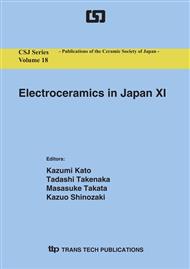p.85
p.89
p.93
p.97
p.103
p.107
p.111
p.115
p.119
Influence of Synthesis Condition on N2 Adsorption Characteristics of Anatase TiO2 Particles Prepared in an Aqueous Solution
Abstract:
TiO2 was crystallized to form particles in aqueous solutions containing ammonium hexafluorotitanate and boric acid. XRD diffraction patterns indicated they were in a single phase of anatase TiO2. TiO2 particles prepared at 90 °C exhibited N2 adsorption-desorption isotherms of type IV. BET specific surface area of the particles was estimated to 13 m2/g. On the other hand, TiO2 particles prepared at 50 °C exhibited N2 adsorption-desorption isotherms of type I. BET specific surface area of the particles was estimated to 168 m2/g. Crystal growth of TiO2 was strongly affected by synthesis temperature. Nano-sized pores or surface structure of TiO2 particles prepared at 50 °C would increase N2 adsorption volume to realize high BET specific surface area. Additionally, aqueous solution process described here had an advantage that TiO2 crystallized at ambient temperature. Anatase TiO2 was prepared without annealing at high temperature which caused aggregation of particles and disappearance of surface nanostructures. The particles with large surface area can be thus utilized for catalyst, cosmetic, photocatalyst, dye-sensitized solar cell or sensors.
Info:
Periodical:
Pages:
103-106
Citation:
Online since:
September 2008
Authors:
Price:
Сopyright:
© 2009 Trans Tech Publications Ltd. All Rights Reserved
Share:
Citation:


